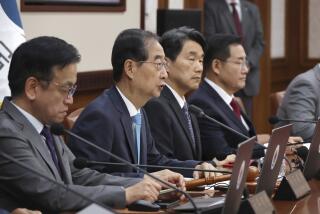North, South Korea Agree on Rules for First Summit
- Share via
SEOUL — North and South Korean negotiators hammered out an agreement Saturday on the ground rules for their first summit meeting after resolving the thorny issue of visits by South Korean advance teams to help ensure security in North Korea’s capital.
After two days of talks in the village of Panmunjom on the border between North and South, the two sides agreed that South Korean President Kim Young Sam and a 180-member entourage would travel by road July 25 from Seoul to Pyongyang. There, Kim would hold two rounds of talks with Kim Il Sung, 82, the leader of the Communist North, during a three-day visit.
But there was no mention of a proposed return visit by Kim Il Sung to Seoul or of any plans for talks with the aging dictator’s son and designated successor, Kim Chong Il, 54. The younger Kim is in charge of internal security, the armed forces and, according to North Korea experts and defectors, most day-to-day administration.
The summit, the first since the Korean peninsula was divided 49 years ago at the end of World War II, is seen as a potential key to resolving a dispute over Pyongyang’s suspected nuclear program and easing tensions between the booming, capitalist South and the hermitic, Stalinist North.
In the absence of a peace treaty since a 1953 truce was signed after three years of fighting, the two Koreas are still bitter enemies. Their border is the most heavily militarized in the world.
In an indication of continuing hostilities, the South Korean intelligence agency Saturday announced the arrest of 23 alleged North Korean agents who it said were involved in efforts to infiltrate labor unions and foment strikes. The National Security Planning Agency said the 23 had been working throughout the country since January, 1993.
In Saturday’s 14-point deal, which followed a broad accord Tuesday on holding a summit meeting in Pyongyang, the two sides agreed that Kim Young Sam and his 100-member delegation, plus 80 reporters, would drive to Panmunjom, where they would transfer to North Korean vehicles for the rest of the road trip to Pyongyang.
They also agreed that South Korean advance teams would visit Pyongyang twice before the summit to work out security, protocol, communications and other arrangements. They pledged not to play their respective national anthems or raise their flags at the summit, because neither yet recognizes the other as a legitimate sovereign state.
More to Read
Sign up for Essential California
The most important California stories and recommendations in your inbox every morning.
You may occasionally receive promotional content from the Los Angeles Times.










